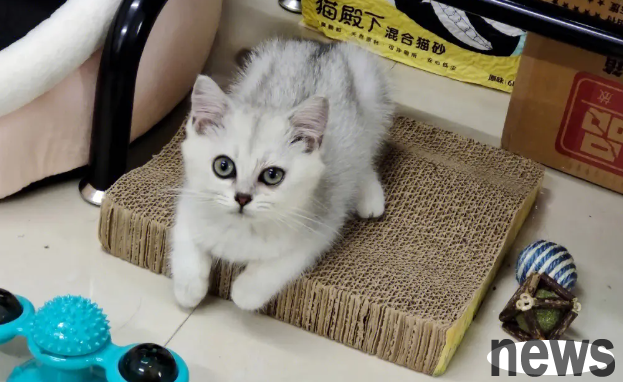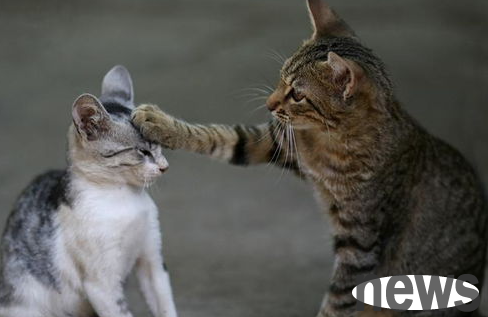Female leukemia is not exactly the same as the human leukemia we are familiar with. It is a malignant tumor infectious disease caused by feline leukemia virus (FeLV) infection. Its main characteristics are malignant lymphoma, myeloid leukemia, and non-regenetic anemia. This disease has no obvious seasonality, a long incubation period and a short course of disease.

1. Risk group
Kitten and other felines. Kittens and cats with low immunity are most susceptible, but their susceptibility decreases with age.
Cat leukemia cannot be completely cured, 3 terrible things let you know that cats are also fragile
2. Symptoms/Symptoms
Cats carrying viruses may not have any symptoms, but because the virus can cause cats to lose their immunity, cats will gradually become weak and sickly over time.
· Loss of appetite/significant weight loss
· Continuous high fever
· Swelling of lymph nodes/tumors on the surface
· Pale mucosal (anemia)
· Messy hair
· Long-term diarrhea
· Convulsions or other neurological symptoms, etc.
If the cat shows the above symptoms, parents should quickly send the cat to a regular animal hospital for diagnosis and treatment. Cats infected with FeLV may show one or more disease symptoms, and the severity of the disease is often related to factors such as FeLV subtype, cat's age, and immune status.
· Malignant lymphoma
Such as thymic lymphoma (causing swallowing and breathing difficulties, which are common in adult cats), gastrointestinal lymphoma (this type is more common, accounting for about 30% of cases), multiple lymphoma (supervised lesions of the body can be touched by hand), etc.
· Lymphocytic leukemia
may occur alone or in combination with malignant lymphoma.
· Red blood cells and bone marrow leukemia
include myeloproliferative diseases, etc., and are the most common hematologic tumors in cats.
·Fibrosarcoma
is the most common subcutaneous malignant tumor in cats.
· Myelodysplastic syndrome
The main characteristics are anemia, leukopenia or thrombocytopenia, and mucosal paleness can be seen in the naked eye.
· Immunosuppression
T and B lymphocytes are reduced, and cats are immune to reduced, which is prone to secondary infection. In particular, co-infection of feline HIV (FIV) and FeLV can aggravate immunosuppression and increase the possibility of lymphoma in cats.
· Enteropathy
is caused by virus attacking intestinal epithelial cells, and cats may experience long-term diarrhea.
· Reproductive disorder
Pregnant female cats may cause miscarriage after being infected with cat leukemia virus. If the fetus is lucky enough to be delivered normally, they will show symptoms of FeLV infection such as weakness and prone to illness.
How to diagnose?
· Routine blood tests: leukocytes, anemia, reduced red blood cells, hemoglobin, and hemocytic pack (HCT), and the number of platelets is very small or even not observed in some field of view. Among them, Fe LV infection is indicated when the increase in white blood cells is largely mainly due to the increase in large lymphoid cells.
· Blood biochemical examination
total serum protein (TP), cholesterol and blood calcium decreased, glucose, creatine kinase, serum aspartate aminotransferase (AST) increased, and serum albumin, glutaranine aminotransferase (ALT), total bilirubin and direct bilirubin remained basically unchanged, which indicates Fe LV infection.
· Kit and test strip testing
├Webmaster's recommendation: cat fleas, more pet health knowledge, the imported cat leukemia detection kit commonly used in clinical practice to detect cats' whole blood, serum or saliva, only 0.05mL of whole blood is required. Since this method requires detection of antibodies in cats, and the incubation period after virus infection is 3-4 weeks, this method can only diagnose cats infected for more than one month.
Note: The rapid diagnosis test strip for cat leukemia virus is relatively simple and fast, and the results can be read within 5-10 minutes, but the false positive rate is high and it is easy to misdiagnose, so it is not recommended to use it.
· Laboratory diagnosis will be performed if necessary. Laboratory diagnosis results are more accurate and can rule out viruses produced by vaccination.
Note: Hemochromatosis, immune-mediated hemolytic anemia and other diseases can also cause symptoms of anemia in cats, and inflammation in the body can also lead to leukocyte growth. In addition, cat immunodeficiency virus infection (female AIDS) can also cause symptoms of immune incompleteness in cats. Therefore, experienced veterinarians need to conduct a comprehensive analysis of the cat's symptoms and laboratory results to avoid misdiagnosis and delay the condition.
Infection channels/methods:
The source of this disease is cats and diseased cats in the incubation period. Their saliva, feces, urine, milk, nasal secretions, etc. all contain viruses, which can infect healthy cats through the respiratory and digestive tracts. It is mainly oral infection and is directly transmitted through the virus ingested in saliva. Therefore, close contact with sick cats and licking each other are the main transmission modes.

· Being bitten or scratched by a sick cat leads to infection.
· A bite by a blood-sucking insect causes infection.
· In rare cases, it may be transmitted by using the same litter box or food bowl as the sick cat.
· A sick pregnant cat infected the cat while pregnant or breastfeeding.
Treatment method:
There is currently no effective treatment for cat leukemia virus infection, so it can only be treated symptomatically. However, according to previous years' cases and related reports, cats still have the chance to recover, and parents can provide care and support treatment as much as possible within their ability.
· Whole blood transfusion or eluten injection for treatment of anemia.
·Use antiviral drugs such as interferon
·Use antibiotics to prevent concurrent infections, prevent sepsis caused by bacterial infections, etc..
· Treatment of dehydration and anorexia
Note: The most effective "drug" to fight viral diseases is the cat's own resistance. Therefore, in addition to intravenous injection of nutrients such as glucose solution, parents also need to ensure that the cat has sufficient food. If the cat has poor appetite, parents can feed a small amount of AD canned food or the cat's favorite food every 2-3 hours to supplement nutrition and ensure drinking water.
· Treatment of concurrent cancer by chemotherapy. Most cats with lymphoma will die within 2 months without treatment, and the cat's survival time after chemotherapy is about 10-12 months.
Note: The specific treatment plan must be followed by the doctor's advice. If you need to take digestive aids or health products (lactase, probiotics, etc.) to regulate the gastrointestinal function of cats and promote diet, you should note that such drugs should be taken separately from antibiotic drugs and should be taken for more than half an hour apart.
How to prevent cat leukemia virus infection:
· Try to avoid your cat playing and playing with cats with unknown health outside to prevent bites and scratches.
· Whether it is a cathouse or a family, it must be tested for FeLV before accepting a new cat.
· Many FeLV-positive cats can survive well, but will continue to detoxify, so they must be isolated from other healthy cats, otherwise the chance of healthy cats being infected can reach 10% to 15%.
· Pay attention to environmental sanitation, regularly disinfect cat utensils, and provide cats with a healthy and clean living environment.
· Reasonably match diet, balanced nutrition, and improve cats' autoimmunity.
· Vaccination is also one of the methods of prevention. However, the various Fe LV vaccines on the market can only provide partial protection, and the vaccines are ineffective for individuals who have been infected with Fe LV. Therefore, before vaccination, you should check whether the cat is infected with the virus. The potential adverse consequence of
FeLV vaccination is that the injection site may cause sarcoma growth. The recommended injection site is at the back or tail of the left thigh. If a sarcoma occurs at the injection site, surgery can be performed directly. Therefore, before getting the FeLV vaccine, parents need to consider the risks that the vaccine may bring.
The symptoms of cats in the early stage of FeLV infection are not obvious. Parents need to observe their cats frequently to see if there are signs of weakness, swollen lymph nodes, difficulty breathing, or other underlying diseases.
You can use alcohol, acid disinfectants or boiling water to disinfect your living environment and cat utensils daily, and pay attention to protecting your utensils during disinfection.
If the physical condition of the cat is no longer suitable for treatment, what parents can do is to accompany the cats more so that they are not lonely or afraid. Euthanasia will be the best way for cats to get rid of.